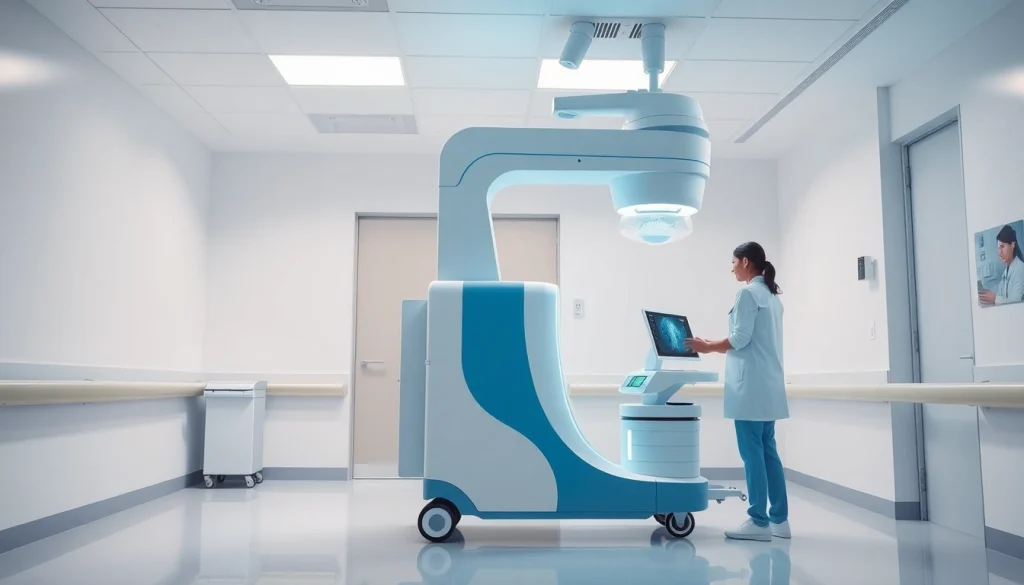Understanding Mobile X-Ray Systems
What is a Mobile X-Ray System?
A mobile x-ray system is a portable imaging device designed to provide high-quality radiographic images in a variety of healthcare settings. Unlike traditional stationary x-ray machines, mobile x-ray systems are equipped with wheels or mobility features that allow them to be easily transported throughout hospital facilities, clinics, or even to patients’ homes. This technology is particularly useful for patients who are unable to move to traditional imaging locations due to illness, injury, or mobility limitations.
Typically, mobile x-ray systems utilize digital imaging technology, enabling real-time image acquisition and processing. The latest models are compact, efficient, and user-friendly, boasting advanced features such as automatic exposure control, integrated digital displays, and wireless connectivity for image transfer. By seamlessly integrating into existing healthcare workflows, these systems enhance patient diagnosis and treatment, contributing significantly to improved healthcare delivery.
Key Features and Benefits
Mobile x-ray systems come with a myriad of features tailored to enhance their functionality and effectiveness. Here are some key features and benefits that make mobile x-ray systems indispensable in modern healthcare:
- Portability: The most significant advantage is the ability to bring imaging capabilities directly to the patient, reducing the need for transport and minimizing discomfort.
- Real-time Imaging: With digital sensors, these systems provide immediate image feedback, allowing for quicker diagnoses and timely treatment decisions.
- Easy to Use: Modern mobile x-ray systems are typically designed with user-friendly interfaces that allow for quick training of staff and efficient operation.
- Improved Patient Comfort: By eliminating the need to move ill or injured patients, mobile x-ray systems significantly enhance patient comfort during the imaging process.
- Versatile Applications: They are used in various healthcare settings, including emergency departments, intensive care units, and home care services.
- Digital Capabilities: Many systems come equipped with wireless capabilities for instant image sharing, enhancing collaborative decision-making among healthcare providers.
Applications in Healthcare Settings
The versatility of mobile x-ray systems allows for their application across a broad spectrum of healthcare environments:
- Emergency Medical Services (EMS): Mobile x-ray is essential in pre-hospital situations, providing rapid imaging for trauma patients while en route to the hospital.
- Intensive Care Units (ICU): Patients in critical condition often require imaging that cannot be performed outside their beds. Mobile x-ray systems facilitate this need with minimal risk of patient transport.
- Pediatrics: Children generally feel anxious about traditional x-ray setups. The ease of bedside imaging offered by mobile systems is particularly beneficial in pediatric care.
- Home Care: For patients requiring long-term care, mobile x-ray systems can be an invaluable asset for delivering necessary imaging without requiring hospital visits.
Integrating Mobile X-Ray Systems into Practice
Assessing Your Facility’s Needs
Before implementing a mobile x-ray system, healthcare providers must carefully assess their facility’s specific needs. Understanding why and how to integrate this technology is paramount. Facilities should consider patient demographics, common medical conditions treated, and the current limitations of existing imaging resources.
Key questions to evaluate include:
- What percentage of patients would benefit from portable x-ray services?
- What are the current imaging turnaround times, and can they be improved?
- How will the introduction of mobile x-ray technology fit into existing workflows and patient management strategies?
Choosing the Right Mobile X-Ray System
The selection process for a mobile x-ray system should involve thorough research and evaluation of various factors:
- Image Quality: Evaluate systems based on the quality of images produced, paying attention to resolution, contrast, and clarity.
- Weight and Portability: Lighter models may be preferable for ease of transport, especially in tight facilities.
- Battery Life: Consider systems with longer battery life for extended use in areas without immediate access to power.
- Software and Compatibility: Ensure that the mobile x-ray system integrates seamlessly with existing electronic health records (EHR) and imaging software.
Implementation Strategies for Success
Once the right mobile x-ray system is acquired, successful implementation is crucial. Strategies may include:
- Staff Training: Comprehensive training sessions for radiologists, nursing staff, and technicians are essential to ensure proficiency.
- Pilot Testing: Roll out the system in phases, conducting pilot tests to identify any operational challenges before full-scale implementation.
- Feedback Mechanism: Establish a system to collect feedback from end-users, which can guide future improvements in operational procedures.
Best Practices for Operating Mobile X-Ray Systems
Training Staff for Optimal Use
Effective training programs should include both theoretical and practical components. Staff need to understand the technical aspects of the mobile x-ray system and its clinical applications. Training can include:
- Simulated usage scenarios for hands-on practice.
- Workshops led by manufacturers to ensure staff are familiar with specific features and troubleshooting techniques.
- Regular refresher courses and updates as new technologies or protocols emerge.
Maintenance and Safety Protocols
To ensure longevity and reliability, routine maintenance of mobile x-ray systems is critical. Maintenance protocols should consist of:
- Regular Inspections: Establish a schedule for routine checks to identify any potential issues before they affect service.
- Cleansing Protocols: Implement protocols to regularly clean components, maintaining the system’s operational integrity and minimizing infection risks.
- Safety Checks: Regularly confirm the calibration and function of the radiation source and image receptor to adhere to safety standards.
Quality Assurance and Performance Metrics
Quality assurance (QA) measures are vital for maximizing the value derived from mobile x-ray systems. Establishing performance metrics involves:
- Image Quality Assessments: Regularly review images produced by the system for clarity and accuracy.
- Turnaround Times: Monitor and analyze the time from imaging to diagnosis to assess efficiency improvements.
- Patient Feedback: Gather patient satisfaction surveys that indicate comfort levels and overall experiences with mobile x-ray procedures.
Cost Considerations and Financing Options
Evaluating Total Cost of Ownership
When considering a mobile x-ray system, it is essential to evaluate the total cost of ownership (TCO). This analysis goes beyond the initial purchase price and encompasses:
- Operational costs such as maintenance, staffing, and training.
- Potential revenue generation through enhanced patient throughput and service offerings.
- Depreciation and potential tax implications of the capital investment.
Potential ROI from Mobile X-Ray Systems
The return on investment (ROI) from integrating mobile x-ray systems can be significant. Benefits may manifest in the following ways:
- Increased Revenue: By expanding services to include mobile x-ray capabilities, facilities can attract more patients and increase billing opportunities.
- Operational Efficiency: Reducing patient transport can lead to more efficient use of resources and shorter wait times.
- Improved Patient Satisfaction: Better patient experiences can lead to higher retention and referrals, positively impacting the facility’s reputation.
Exploring Financing and Leasing Solutions
Organizations seeking to adopt mobile x-ray systems should explore various financing options, including leasing, loans, and vendor financing programs:
- Leasing Agreements: Often allow facilities to access high-quality equipment with lower initial costs.
- Loan Options: Many banks and financial institutions offer loans specifically tailored for medical equipment purchases.
- Government Grants: Investigating grants or subsidy programs may provide additional financial assistance. Healthcare organizations should always look for funding opportunities to help offset costs associated with new technologies.
The Future of Mobile X-Ray Technology
Innovations and Emerging Trends
The landscape of mobile x-ray technology is constantly evolving, marked by innovative advancements and trends that are reshaping its future:
- AI Integration: Artificial intelligence (AI) is being explored for enhanced image analysis and interpretation, potentially reducing workload for radiologists.
- Remote Diagnostics: The ability to transmit images directly to specialists for remote consultation enhances patient care in underserved areas.
- Wireless and Cloud Technology: Advances in wireless technology will allow for faster and more secure transfers of images to electronic health record systems.
Impact on Patient Care Delivery
The advancements in mobile x-ray systems have a profound impact on patient care:
- Faster Diagnosis: Quicker access to imaging can lead to more timely treatment and improved patient outcomes.
- Enhanced Access: Patients with mobility challenges or those in rural areas can receive critical diagnostic services closer to home.
- Adaptation to Emergency Situations: Mobile x-ray units are vital in disaster responses, enabling medical personnel to assess injuries quickly in crisis situations.
Future-Proofing Your Mobile Imaging Solutions
As technology continues to evolve, mobile x-ray systems must be adaptable to integrate new advancements. Organizations should:
- Invest in Scalable Solutions: Acquire systems that allow for updates and enhancements to future-proof investments.
- Stay Informed: Actively engage in industry conferences, workshops, and publications to remain current with emerging technologies and best practices.
- Foster Collaborations: Partner with manufacturers and consultants to explore new developments and opportunities for synergistic growth.



